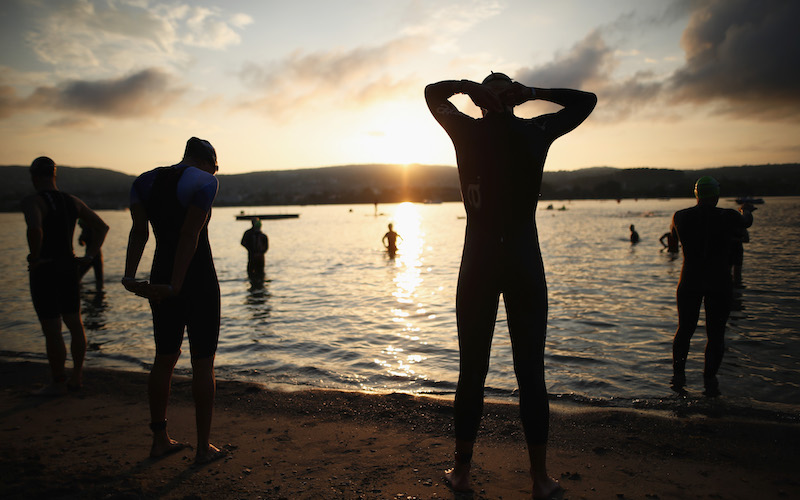Written by Danny Sawaya, StrongFirst Team Leader and NSCA CSCS

In the world of competitive sports, it is no secret that when athletes of similar skill levels go head to head, the stronger athlete usually prevails. Even though many athletes know this, focusing on strength has been looked down upon by some endurance athletes because it has been confused with increased muscularity and size that can be counterproductive. There is a misconception that lifting weights leads to excessively ‘bulky’ muscles. This thought process is just about as ridiculous as saying, “I don’t want to start running because I may get too fast.” The truth is, training for strength and power development is drastically different than training for hypertrophy (increase in muscular size). Committing to the correct training program, as well as the appropriate exercises, is crucial to make sure you are seeing the specific gains you are looking for. Though each athlete may need some variations of the following exercises based on their specific needs, the movements listed below have the best carry-over to help triathletes improve strength, power, and symmetry.
Single Legged Deadlift (SLDL)
Purpose: Unilateral Strength, Posterior Chain Strength, Core Stability, Gluteal Activation
Want to work on imbalances in your hips and trunk? The SLDL can be a bit humbling since it highlights all of your weaknesses, but you will be grateful when you master it. Running and cycling are unilateral leg movements, so strength training each leg individually is important. The SLDL, if executed correctly, will stimulate glute activation better than nearly any other exercise, and lack of gluteal strength is a big complaint for many triathletes.

The most important part of this movement is to master the hip hinge then take the appropriate steps to work to one leg. This isn’t a yoga stick pose with straight legs, it is a hinge. It is best to start this exercise with no weight and possibly using a wall to balance. After it is mastered with body weight only, progress by holding dumbbells in one or both hands. Make sure not to rush through the SLDL in a hurry to get done; remember, the most important part is mastering the movement. The video shows a progression from two legs, but you can also use a pole or wall to balance against while learning. It is important not to turn this into a circus act and fight balance the entire time.
Kettlebell Swing
Purpose: Power Development, Gluteal and Hamstring Strength (Posterior Chain Strength)
These odd-shaped metal balls with a handle can transform movement and help most people train power and explosiveness with a relatively small learning curve. The key is to make sure to execute the movements correctly. The goal of the swing is to utilize the glutes and hips to develop all the power, and to let the arms float as a result of the power developed in the lower body. The swing involves the hamstrings, glutes, abdominals, and lower back all in a coordinated effort. One of the biggest mistakes people make with kettlebells is they squat into the movement (emphasizing the quads) rather than hinging, which puts the focus on the posterior chain of the body.

You can also use the kettlebell for an awesome conditioning session, but in the world of endurance sports it is more crucial to program the kettlebell for power and strength. This can be accomplished by keeping the repetitions of the swing between 5 and 10 per set and focusing on being explosive with each rep rather than just finishing the movement. The video below gives a good visual of the mechanics of the swing.
Goblet Squat
Purpose: Leg Strength and Power Development
Squatting in general is important for overall strength and power development. Goblet squats are a great movement for the beginner to advanced athlete because there is a low learning curve. As an added benefit, holding the weight in front of the body with proper form does not put pressure directly on the spine. It will also activate the abdominal muscles to brace the trunk while keeping the upper back straight. In this exercise, it is vital to squat below parallel, which means having the crease of the hips drop below the knees. There is a common misconception that squatting below the knees is harmful. If someone cannot squat below parallel without pain, this is an indication of poor mobility and indicates a higher risk for injuries. If this is an issue for you, I highly recommend you back off the running and focus on mobility and correctives for awhile if you want to spend more time participating in the sport than watching on the sidelines.

Inverted Row
Purpose: Back Strength and Trunk Stability
Upper back strength is crucial for improved posture and performance. It is very common to see cyclists with underdeveloped back strength. Spending excessive time in a flexed position causes muscles to be stretched and weak. The inverted row can be executed using a barbell mounted on a squat rack or suspension training units, such as a TRX. The benefit is that you are actually lifting your own body weight and learning how to engage numerous muscles at the same time. It is important to keep the abdominals and glutes engaged when possible while doing an inverted row. With this exercise, resistance and difficulty can be adjusted by simply changing body position. The more upright the body is, the easier the movement. The more horizontal to the ground, the more difficult it will be. Another key factor is to find the position that will engage the back muscles and focus on squeezing the back muscles and pulling the shoulder blades down and together during the movement. Many times people go through this exercise and bypass the back by using the arms as the primary mover. Focus on opening up the chest and pinching the shoulder blades together during this movement. If it feels too difficult, walk the body more upright to make it easier or bend the knees and put your feet flat on the ground.

Turkish Get-Up
Purpose: Full body strength and motor control, Shoulder mobility and stability, trunk stability
The turkish get-up works core strength, hip and shoulder mobility, stability, as well as unilateral lower body movement all wrapped into one movement. It has been said if a person could only do one exercise to become a strong human being…this should be it. Proper instruction is important in learning and mastering this exercise, but it will be well worth your time.

I always start by teaching this movement with absolutely no weight at first. Many individuals may have to stay weightless for a period to ensure they are mastering the movement with proper form. It isn’t important to rush through this exercise, it is important to be great at each of the movements and not progress to the next phase until you are doing well with everything leading up to it. Being able to move through this full range of movement with a kettlebell or dumbbell held overhead is a great way to help make yourself bulletproof. See video below for demonstration and instruction.
LEG DROPS
Purpose: Core Stability, Unilateral Leg Movement with Core Activation
This core/trunk exercise is a must for runners and cyclists. Many individuals live with anteriorly rotated hips (top of the hips pitching forward). When this occurs, the lower back may have an increased curvature which could cause a flared rib cage; this scenario is a recipe for disaster. When executing core work, a big rib flare may lead to less effective core work being done. It is crucial that the rib cage be down toward the hips. This is also helps to allow for optimal diaphragmatic breathing to occur. This concept could probably take up an entire book.
To execute this exercise, lie on your back, bend both knees, and place feet on the ground. Place a band underneath the lordotic curve of the lumbar spine and tighten the abdominals, forcing the rib cage down (like you’re bracing to be punched in the stomach, do not pull the belly button in towards the spine). Try to imagine that you are crushing the band with your lower back. Now have someone pull on the band, as though they are trying to take it away from you. Once the pressure is good, extend and raise one of your legs, then slowly begin to lower it while keeping pressure on the band. If you feel the lower back start to come up off the ground, bring the leg back up to maintain tension on the band. Try to get your leg lower with each rep without losing the lower back position. Do about 3 reps per leg and work up to 3-5 sets total. Once this becomes easier, move to a more advanced version of this exercise and extend both legs up to vertical and lower one leg at at a time, ensuring pressure on the band is maintained.
In general, the philosophy for programming these movements is to always keep something in the tank. With strength training, it is imperative not to push to failure, and as a result grind out slow reps. I always encourage my athletes to keep lifts fast and explosive. During parts of the year with higher volumes of running and cycling these exercises will be a great compliment to offer balance and recovery in a training cycle.
 About the Author: Danny Sawaya CSCS, FMS is a Certified Strength and Conditioning Specialist with over 17 years of experience as trainer and strength coach. He owns Evolution Fitness, a Strength and Conditioning facility in Tucson, Arizona. He specializes in corrective exercise, Russian Kettlebell Training, powerlifting, and strength and conditioning. He works with a full array of individuals, ranging from beginners to Olympians looking to improve movement and strength.
About the Author: Danny Sawaya CSCS, FMS is a Certified Strength and Conditioning Specialist with over 17 years of experience as trainer and strength coach. He owns Evolution Fitness, a Strength and Conditioning facility in Tucson, Arizona. He specializes in corrective exercise, Russian Kettlebell Training, powerlifting, and strength and conditioning. He works with a full array of individuals, ranging from beginners to Olympians looking to improve movement and strength.
